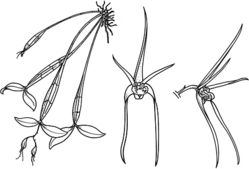Common name: Spider Orchid
Dendrobium tetragonum var. melaleucaphilum (M.A.Clem. & D.L.Jones) Dockrill APNI* Synonyms: Dendrobium melaleucaphilum M.A.Clem. & D.L.Jones APNI*
Tetrabaculum melaleucaphilum (M.A.Clem. & D.L.Jones) M.A.Clem. & D.L.Jones APNI*

Description: Epiphyte or occasionally an epilith, stems spreading to pendent, thin and wiry in the basal half, succulent, swollen and square in cross section in the upper half, tapering towards the tip, rooting only at the base, 6–45 cm long, 7–9 mm diam., with 2–4 leaves at apex; roots smooth, creeping.
Leaves spreading to erect, elliptic, 4.5–9 cm long, 15–25 mm wide, conduplicate, acuminate, thin, smooth.
Inflorescences 0.7–4 cm long, 2–8-flowered. Sepals and lateral petals green to deep dull yellow with reddish margins or other markings; dorsal sepal 38–60 mm long, 2–5 mm wide; labellum cream with reddish striations, 10–16 mm long, 7–9 mm wide. Column 2.5–4 mm long; column foot 6–10 mm long.
Flowering: July–October
Distribution and occurrence: Grows frequently on Melaleuca styphelioides, less commonly on rainforest trees or on rocks in coastal districts; north from the lower Blue Mtns.
NSW subdivisions: NC, CC
Other Australian states: Qld
Previously known as the 'large-flowered paperbark form' of D. tetragonum, and as D. melaleucaphilum. Dendrobium tetragonum is a complex of forms, some of which have been recognised as separate species, which is how D. tetragonum var. melaleucaphilum was treated in the Flora of New South Wales Volume 4 (1993). There is no doubt that plants of D. tetragonum var. tetragonum and D. tetragonum var. melaleucaphilum are different, but whether those differences reflect separate species status has not been addressed empirically. Therefore, we adopt a conservative stance on the circumscription of D. tetragonum which treats morphotypes in New South Wales as varieties. Publication of empirical evidence supporting separate species status for these varieties will result in their being recognised as such.
Text by P. H. Weston, updated by Matt A.M. Renner (23 October 2020)
Taxon concept: Flora of NSW 4 (1993)
APNI* Provides a link to the Australian Plant Name Index (hosted by the Australian National Botanic Gardens) for comprehensive bibliographic data
***The AVH map option provides a detailed interactive Australia wide distribution map drawn from collections held by all major Australian herbaria participating in the Australian Virtual Herbarium project.
|


